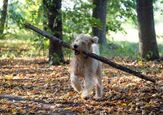Are Agility Competitions in Your Dog's Future?

Think your little buddy has what it takes to compete with the best? Here's how you get started.
Agility training for dogs is gaining serious traction in North America. And after watching an old 2023 clip of a Miniature Schnauzer named Sophie absolutely flying through the many leaps, ladders, and obstacles of the Westminster agility course, I looked over at my Mini, snoring on the sofa and thought, “Why not?”
You see, Mimi is also a Mini Schnauzer, and she loves to get out and hit the dog parks at full speed. Not exactly running and leaping, but walking really, really fast. But I wonder to myself, what if she could pick up the pace, break into a run, and have a little more fun while she’s at it?
If you’re intrigued and think your furry speedster may be a contender, know that literally any breed can qualify for agility trials (maybe not at Crufts or Westminster but at local competitions) and that includes both pure and mixed breeds of any size.
Agility 101 - It’s Not All About the Dog
The American Kennel Club (AKC) highly recommends that, before you begin setting up an obstacle course in your backyard and trying to train your pooch, you actually attend an agility trial to understand the flow and expectations of both the dog and the handler (you!).
Further, enrol in a beginner course that provides you with the basics on how to train your pet and compete against others.
In short, do your homework first.
With Agility 101 in hand, let’s take a look at your good buddy and why you consider him to be a serious contender in competitions of agility.
Pet Attitude
Naturally, your dog needs to be responsive to commands, but there’s a lot more to this type of competition than simply a highly obedient dog.
For example, is your dog:
- Able to focus and pay attention for long periods. In other words, not easily distracted by nearby sounds or activity… or a squirrel he’s spotted along the sidelines.
- Easy to repeatedly motivate with either praise or treats when it comes to taking on typically 14 or more rather daunting obstacles.
- Quick to pick up directional cues from you. Meaning you’re on the same wavelength and he looks to you for guidance as to where to go/what to do next.
- Fully cognizant of the basic commands of sit, stay, come, down, and leave it.
- Loving the chance to learn, run, and work closely with his handler (you!).
Physical Attributes
Of course, any dog that can run quickly enough to compete as well as maneuver themselves through tunnels and over hurdles needs to be in peak physical health.
They should also be:
- Physically strong for their size and with a superior level of stamina. Meaning a resilience and determination to not quit.
- Aware of their body and capable of controlling it as they move through obstacles and make tight turns seem easy. Gangly yet loveable don’t count in agility!
- At least 15 months old and physically mature to prevent bone and joint injury from jumping or bumping into obstacles.
- Spayed or neutered.
- Up-to-date on all vaccines.
What Next?
In between agility classes, there’s no reason you can’t start working with your pet at home.
From the onset, building a bond with your dog is critical, so consider using high-value treats throughout the process and keep things positive. If you lose his eagerness to participate, you’ve lost a competitive dog.
Once you’ve gained his enthusiasm and you’re both on the same page, introduce obstacles such as collapsible tunnels, hoops, jumps and poles he can zig-zag through. Long term, it makes sense to invest in a portable dog agility training kit that you can use indoors, outdoors, or on the road, just to keep him on his toes. And plan to spend 15 to 20 minutes a day on refresher training.
It’s a great sport that can help keep your pooch physically healthy and mentally stimulated. And when it comes to competing… that’s going to be fun for you too!

Sharing space with three seriously judgy Schnoodles and 2 felines who prefers to be left alone. #LivingMyBestLife
More by Mary Simpson























